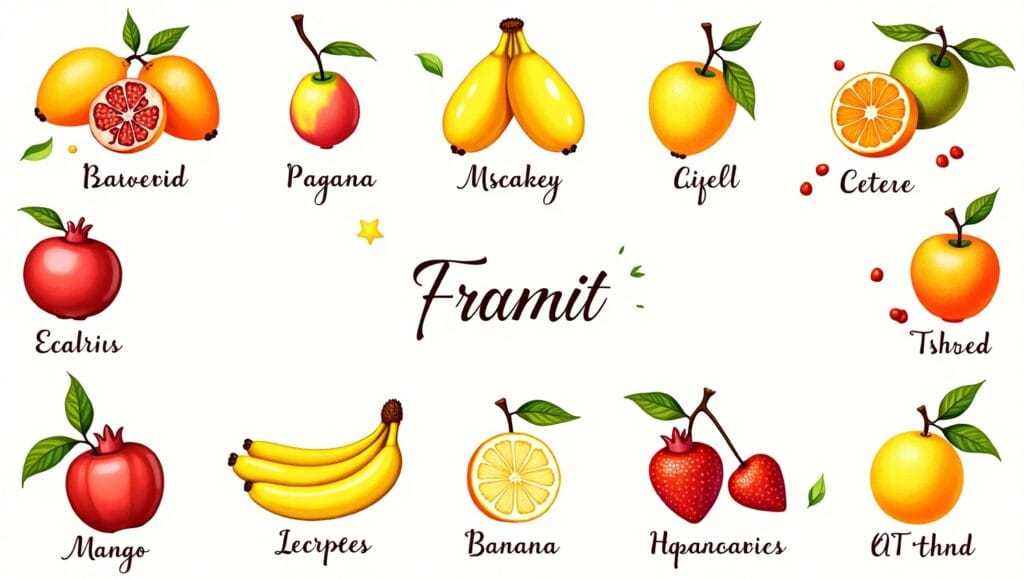Exploring Tamil Fruit Names: A Blend of Tradition and Modernity
The Tamil language, one of the oldest classical languages in the world, boasts a rich vocabulary deeply rooted in culture, nature, and daily life. Fruits, an essential part of Tamil cuisine and traditions, often carry names that reflect their characteristics, origins, or cultural significance. In this article, we explore the Tamil names of both traditional and exotic fruits, highlighting how language evolves to embrace global influences while preserving its heritage.

Traditional Tamil Fruits and Their Native Names
Tamil Nadu’s tropical climate nurtures a variety of indigenous fruits, many of which have ancient Tamil names:
- மாங்காய் (Māṅkāy) – Mango
- The “king of fruits” in India, mangoes hold cultural and religious significance. The unripe fruit is called மாங்காய், while the ripe one is மாம்பழம் (Māmbaḻam).
- வாழைப்பழம் (Vāḻaippaḻam) – Banana
- Bananas are integral to Tamil rituals, festivals, and meals. Varieties like ரச வாழை (Rasa Vāḻai) and பூவாழை (Pūvāḻai) are popular.
- அன்னாசிப் பழம் (Annāsi Paḻam) – Pineapple
- Named for its spiky exterior, அன்னாசி is used in Tamil Nadu’s tangy curries and desserts.
- பப்பாளிப் பழம் (Pappāḻi Paḻam) – Papaya
- Known for its digestive benefits, papaya is a breakfast staple.
- கொய்யா (Koyyā) – Guava
- This fiber-rich fruit is often eaten raw with chili powder.
Exotic Fruits in Tamil: Adapting Global Names
With globalization, exotic fruits have entered Tamil markets. Their names are often phonetic adaptations of English terms:
- கிவி பழம் (Kivi Paḻam) – Kiwi Fruit
- The name கிவி mirrors the English “kiwi,” with பழம் (fruit) added for clarity.
- பிட்ராயா பழம் (Piṭrāyā Paḻam) – Dragon Fruit
- Also called அக்னி கெண்டை பழம் (Agni Keṇṭai Paḻam), meaning “fire cactus fruit,” referencing its vibrant pink skin.
- கிரான்பெரி பழம் (Kirānperi Paḻam) – Cranberry
- Retains its English name in Tamil due to its foreign origin.
- ஆரஞ்சு (Ārañju) – Orange
- Derived from the Portuguese word “laranja,” showing colonial linguistic influences.
Cultural Significance of Fruits in Tamil Nadu
Fruits are more than just food in Tamil culture:
- Religious Offerings: Bananas, coconuts (தேங்காய்), and mango leaves are used in prayers.
- Festivals: Jackfruit (பலா பழம்) and sugarcane (கரம்புச் செடி) feature in Pongal celebrations.
- Ayurveda: Fruits like amla (நெல்லிக்காய்) and pomegranate (மாதுளை) are used for medicinal purposes.
Why Do Some Fruits Retain English Names?
- Foreign Origin: Fruits like kiwi or cranberry lack native Tamil names due to their recent introduction.
- Phonetic Ease: Adapting English terms (e.g., கிரான்பெரி) makes communication easier in markets.
- Lack of Historical Context: Fruits absent in ancient Tamil texts often retain their global names.
Preserving Tamil Fruit Vocabulary
While modern adaptations are practical, efforts to preserve traditional Tamil names are vital. For example:
- மாதுளை (Māthuḷai) – Pomegranate (an ancient name with mentions in Sangam literature).
- நெல்லிக்காய் (Nellikkāy) – Indian Gooseberry (revered in Ayurveda).
Organizations and schools in Tamil Nadu are reviving interest in native terms through educational programs and culinary workshops.
Conclusion
Tamil fruit names beautifully illustrate the language’s adaptability and cultural depth. While native terms like மாங்காய் and வாழைப்பழம் connect Tamils to their roots, phonetic adaptations like கிவி reflect the dynamic nature of language in a globalized world. By celebrating both traditional and modern terms, we honor Tamil’s linguistic legacy while embracing new influences.